
Erythranthe guttata, with the common names seep monkeyflower and common yellow monkeyflower, is a yellow bee-pollinated annual or perennial plant. It was formerly known as Mimulus guttatus.

Diplacus rupicola, the Death Valley monkeyflower, is a flowering plant in the family Phrymaceae.

Erythranthe cardinalis, the scarlet monkeyflower, is a flowering perennial in the family Phrymaceae. Together with other species in Mimulus section Erythranthe, it serves as a model system for studying pollinator-based reproductive isolation. It was formerly known as Mimulus cardinalis.

Erythranthe nudata, the bare monkeyflower, is a species of monkeyflower endemic to the serpentine soils of Colusa, Lake and Napa Counties in California. It is an annual flower with bright yellow tube-shaped blooms and small narrow leaves.
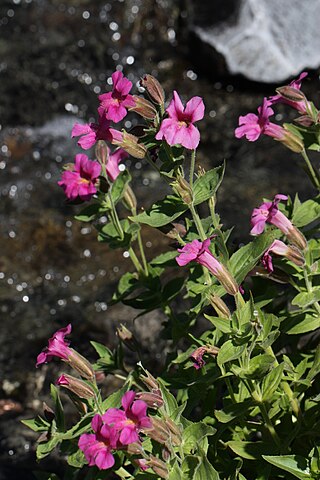
Erythranthe lewisii is a perennial plant in the family Phrymaceae. It is named in honor of explorer Meriwether Lewis. Together with other species in Erythranthe, it serves as a model system for studying pollinator-based reproductive isolation. It was formerly known as Mimulus lewisii.
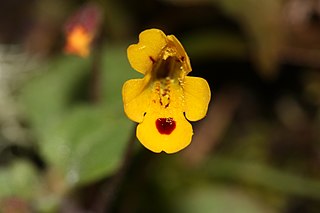
Erythranthe alsinoides is a species of monkeyflower known by the common names wingstem monkeyflower and chickweed monkeyflower. It was formerly known as Mimulus alsinoides.
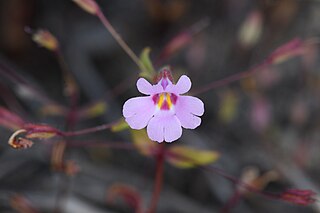
Erythranthe gracilipes is an uncommon species of monkeyflower known by the common name slenderstalk monkeyflower. It was formerly known as Mimulus gracilipes.
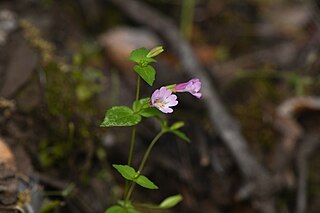
Erythranthe inconspicua, synonym Mimulus inconspicuus, is an uncommon species of monkeyflower known by the common name smallflower monkeyflower.
Erythranthe inflatula, synonyms Mimulus inflatulus and Mimulus evanescens, is a rare species of monkeyflower known by the common name disappearing monkeyflower. It is native to the western United States, where it is known from about ten locations in and around the Great Basin within the states of Idaho, Oregon, and California; it is also found in Nevada. Specimens of the plant had been catalogued as Mimulus breviflorus, but on further examination it was evident that they were a separate, unclassified species; this was described to science in 1995. It is thought that the plant may have evolved via hybridization between Erythranthe breviflora and Erythranthe latidens, or that it evolved from E. latidens and then into E. breviflora.

Erythranthe shevockii is a rare species of monkeyflower known by the common name Kelso Creek monkeyflower. It was formerly known as Mimulus shevockii.
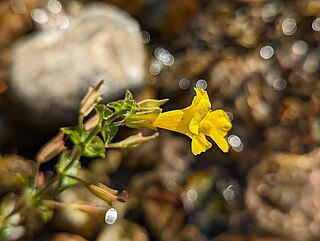
Erythranthe michiganensis is a rare species of flowering plant in the lopseed family, known by the common name Michigan monkeyflower. This species occurs only in the Grand Traverse and Mackinac Straits areas within the American state of Michigan. It is one of only three plant species that are endemic to Michigan, with the other two being Voss's Goldenrod and Packera insulae-regalis.
Erythranthe hymenophylla, synonym Mimulus hymenophyllus, is a species of flowering plant in the lopseed family known by the common names thinsepal monkeyflower and membrane-leaf monkeyflower. It is native to Hells Canyon on the border between Oregon and Idaho in the United States. It has also been reported from Montana.

Erythranthe gemmipara is a rare species of flowering plant in the family Phrymaceae, known by the common name Rocky Mountain monkeyflower. It is endemic to Colorado in the United States, where there are eight known occurrences. It was formerly known as Mimulus gemmiparus.

Erythranthe lutea is a species of monkeyflower also known as yellow monkeyflower, monkey musk, blotched monkey flowers, and blood-drop-emlets. It was formerly known as Mimulus luteus.

Erythranthe, the monkey-flowers and musk-flowers, is a diverse plant genus with more than 120 members in the family Phrymaceae. Erythranthe was originally described as a separate genus, then generally regarded as a section within the genus Mimulus, and recently returned to generic rank. Mimulus sect. Diplacus was segregated from Mimulus as a separate genus at the same time. Mimulus remains as a small genus of eastern North America and the Southern Hemisphere. Molecular data show Erythranthe and Diplacus to be distinct evolutionary lines that are distinct from Mimulus as strictly defined, although this nomenclature is controversial.

Erythranthe suksdorfii, with the common names Suksdorf's monkeyflower and miniature monkeyflower, is an annual flowering plant in the family Phrymaceae (Lopseed). It was formerly known as Mimulus suksdorfii. A specimen collected in Washington state in 1885 by the self-taught immigrant botanist Wilhelm Nikolaus Suksdorf was identified as a new species by Asa Gray in 1886, who named it in Suksdorf's honor. It can easily be misidentified with Erythranthe breviflora, which generally has elliptic leaves rather than the linear or oblong leaves found in E. suksdorfii.

Erythranthe norrisii, formerly Mimulus norrisii, also known as Kaweah monkeyflower, is a species of flowering plant. Kaweah monkeyflower is endemic to the Kaweah River watershed of California in North America and is considered a rare species. Most specimens are known from Sequoia National Park in Tulare County. According to the Flora of North America Association, Kaweah monkeyflower grows in "steep marble outcrops in soil pockets, moss covered marble and quartzite ledges, cracks, fractures, weathered faces, chamise chaparral or blue oak woodlands."

Erythranthe arenaria, formerly Mimulus arenarius, also known as sand-loving monkeyflower, is a species of flowering plant. This plant is native to eastern California in the United States, where it is found in the central and southern Sierra Nevada mountains. Sand-loving monkeyflower is usually found in "sandy flats, sand bars, washes, seasonal creek beds" in the foothills and the High Sierra.

Shaffer Springs, sometimes called Shaffer's Fish Bowl, is a natural seep and minor roadside attraction in the Black Mountains of Arizona, United States. Located in Mohave County, alongside the old alignment of Route 66 that runs between Kingman, Arizona and Oatman, the water from the seep flows into a manmade basin stocked with domestic goldfish. Shaffer Springs serves a vital water source for wild burros.

Erythranthe rhodopetra, also known as the Red Rock Canyon monkeyflower, is a species of plant. Erythranthe rhodopetra is a rare plant native to Kern County, California, United States. According to the California Native Plant Society, "Known only from the El Paso Mtns. Many occurrences historical; need field surveys. Possibly threatened by mining, vehicles, recreational activities, foot traffic, and non-native plants. Previously identified as, and similar to, E. palmeri."


















